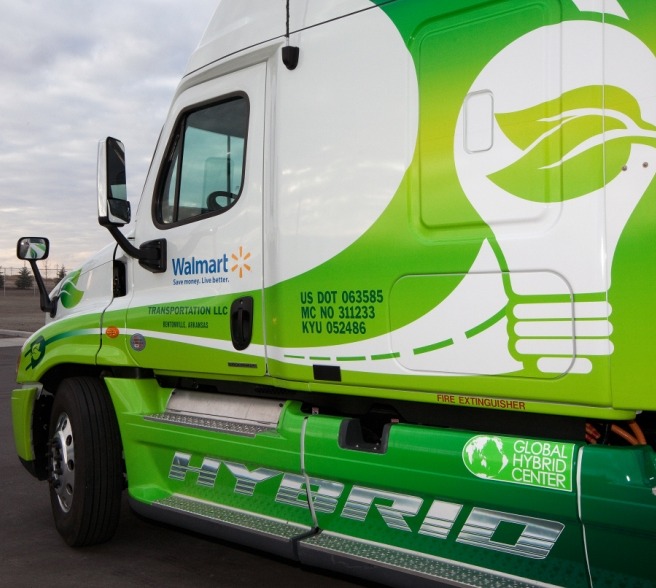
Walmart may have hybrid trucks, but its efforts at going green are a drop in the bucket considering the company's size. (Photo by Walmart Stores.)
This post originally appeared on Energy Self-Reliant States, a resource of the Institute for Local Self-Reliance’s New Rules Project.
While I generally have nothing but praise for the Environmental Protection Agency (EPA), its Green Power Partnership program falls short of the agency’s usual standard. In particular, the program, by providing media recognition for participating companies who procure renewable energy, inflates the activities of large companies at the expense of businesses whose clean energy transformation is much more meaningful.
Take Walmart, who appears at No. 3 in the EPA’s Green Power Partner rankings with an annual procurement of 872 million kilowatt-hours (enough to power approximately 87,000 homes per year). The EPA inaccurately credits the super-retailer with getting 28 percent of its electricity from green power, because the partnership program allows Walmart to cherry-pick its only two regional divisions that have made any strides on green energy (California and Texas).
Nationwide, Walmart gets less than 2 percent of its electricity from renewable energy sources.
But it’s not just that Walmart can green its appearance by narrowing the focus to one or two company divisions. The truth is that many small businesses and towns (and even individuals) can lay claim to much more significant strides on renewable energy. For example, Oak Park, Ill., recently signed a contract for 100 percent renewable electricity, nearly all of which comes from a wind power facility within the state. Bighorn Ace Hardware in Silverthorne, Colo., gets 25 percent of its electricity from solar, built right on top of the building. Even this author can beat Walmart, by using Xcel Energy’s Windsource to get 100 percent of his electricity from wind power.
In truth, Walmart’s vast size means its green power steps have to be equally vast. To match the renewable energy commitment of Bighorn Hardware (as a percent of energy consumption), for example, Walmart would have to install over 5,500 megawatts of solar, three times more than was installed in the entire United States in 2011. And to be 100 percent renewable, it would have to install 20,000 megawatts, enough solar panels to make a bridge from New York to Los Angeles 10 times over.
While Walmart receives good press for its minor commitment to green power, neither Bighorn Ace Hardware nor Oak Park, Ill., will make the EPA’s Top 50 list of Green Power Partners. That’s because EPA ranks businesses by the total size of their purchase, not their relative greenness. The agency may as well list the Fortune 500 in order of electricity consumption.
It would be far more honest to rank companies by a meaningful metric of green power progress, like their green kilowatt-hours per dollar of sales.
The shame is not just that EPA employs the wrong measure of green, but that companies with big energy bills and small commitments to green power get great publicity at the expense of cities, colleges, and businesses who have made real clean energy strides. EPA’s Green Power program could help highlight high-achievers in clean energy, but until its methodology changes, there will be a lot of entities on the list whose green thumbs are overshadowed by enormous energy footprints.
Check out this Grist series for more on Walmart’s greenwashing efforts.



